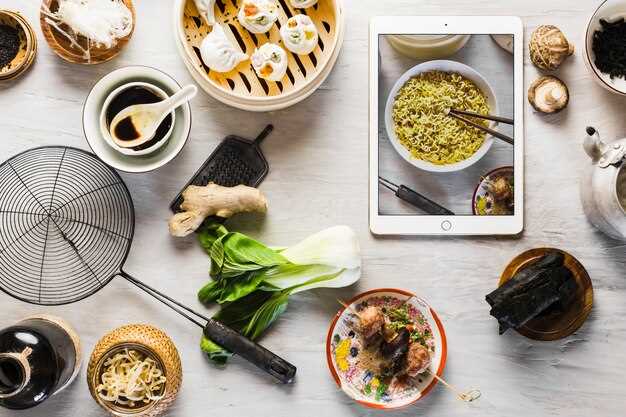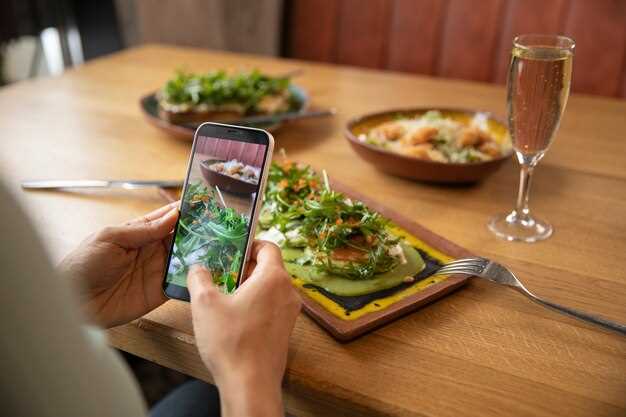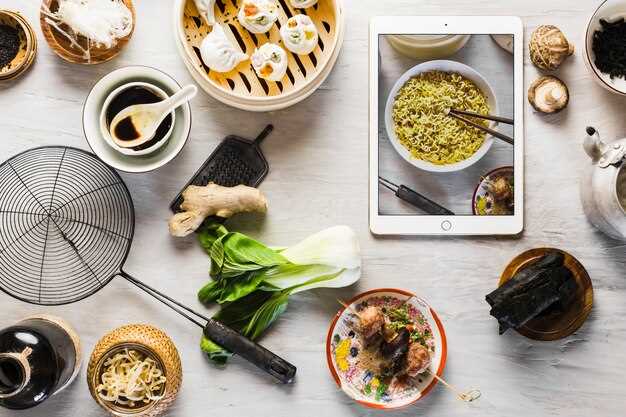Start by embracing hyper-personalized marketing campaigns. With advances in AI technology, restaurants can now analyze customer data to create personalized offers that appeal directly to individual preferences. This level of personalization not only enhances customer experience but also increases the likelihood of repeat visits.
Engage with your community through immersive dining events. These events incorporate augmented reality to transform traditional dining into a multi-sensory experience. Imagine your dishes coming alive through interactive digital art or historical narratives. Such creative events capture attention and encourage sharing on social media, effectively becoming an organic marketing tool.
Optimize content for emerging platforms like the Metaverse. As more people spend time in virtual environments, having a presence there allows restaurants to reach new audiences. Consider virtual tours of your restaurant or hosting virtual cooking classes to attract tech-savvy diners who appreciate innovation.
Build loyalty by implementing a blockchain-based rewards system. This modern approach to loyalty programs ensures transparency and builds trust, as customers can track and verify their rewards securely. With cryptocurrency integration, you can offer unique incentives that stand out in a crowded market.
Incorporate zero-waste policies to attract environmentally-conscious customers. Highlighting sustainability efforts not only improves brand image but also resonates with eco-friendly diners. From composting leftovers to sourcing local produce, showcasing these practices can differentiate your restaurant in competitive markets.
Leveraging Digital Platforms for Enhanced Customer Engagement

Begin by integrating AI-driven chatbots on your restaurant’s website and social media pages to provide instant responses to customer inquiries. These chatbots can handle reservations, answer frequently asked questions, and offer personalized recommendations, enhancing the user experience significantly. Monitor engagement analytics to identify peak interaction times and adjust your digital staffing to ensure optimal customer support when needed most.
Social media polls and interactive stories on platforms like Instagram and Facebook serve as powerful tools to engage with your audience and gather valuable feedback. Use these features to ask questions about new menu items, preferred operating hours, or seasonal specials. Analyze this data to make informed decisions that align with customer preferences, resulting in increased satisfaction and loyalty.
Offer exclusive promotions and discounts through app notifications. Encourage customers to download your restaurant’s mobile app by providing a first-time installation discount. Once users have the app, send push notifications about limited-time offers or special events, incentivizing repeat visits and driving revenue.
| Platform | Strategy | Benefit |
|---|---|---|
| Website | AI-driven chatbots | Improved customer support and satisfaction |
| Instagram/Facebook | Interactive polls and stories | Valuable feedback and customer engagement |
| Mobile App | Exclusive offers via push notifications | Increased customer retention and sales |
Finally, leverage user-generated content by encouraging customers to share their dining experiences and tag your restaurant. Feature this content in your stories or on your website, as personal recommendations can significantly influence potential diners. Recognizing and sharing these posts not only extends your brand’s reach but also fosters a community around your restaurant.
Integrating AI-driven Chatbots for Real-time Customer Interaction
Adopt AI-powered chatbots to enhance customer engagement by offering instant responses to inquiries. Implement chatbots on your website and social media platforms to handle reservations, menu queries, and feedback collection efficiently. Ensure seamless integration with your CRM to personalize interactions based on customer history and preferences.
Optimize chatbot scripts to reflect your restaurant’s tone and personality, making interactions more relatable and engaging. Regularly update the AI with new menu items, promotions, and events to keep customers informed and interested. Incorporating natural language processing enhances the chatbot’s ability to understand nuanced customer input, providing more accurate answers and a human-like conversation flow.
Leverage analytics from chatbot interactions to gain insights into customer preferences, popular dishes, and peak interaction times. Use this data to tailor marketing strategies and improve service delivery effectively. Make sure your chatbots support multiple languages to cater to a diverse clientele, improving accessibility and broadening your customer base.
Provide clear options to escalate the conversation to a human staff member if the chatbot cannot resolve an issue, ensuring customer satisfaction remains high. By integrating AI-driven chatbots, your restaurant can offer 24/7 support, streamline operations, and build a stronger connection with your patrons.
Utilizing Geotargeted Advertising Campaigns
Integrate location-specific promotions to attract local clientele. Leverage platforms like Google Ads and social media to deliver personalized offers based on users’ geographic data. Specifically, design mobile ads that trigger when potential customers are near your restaurant, promoting discounts or special events. According to a 2024 study, businesses implementing geotargeted ads saw an increase in foot traffic by 18%. Ensure that your online profiles and listings, such as Google My Business, accurately reflect your address and contact information to capitalize on local searches. Utilize location data analytics to analyze which areas generate the most responses and refine your campaigns for better engagement. Encourage reviews and check-ins from satisfied customers within targeted areas to enhance your visibility and credibility locally. Regularly assess the conversion rates of these campaigns, fine-tuning them to maintain relevance and cost-effectiveness.
Expanding Reach with Innovative Influencer Collaborations
Partner with micro and nano influencers who resonate deeply with local audiences to foster authentic connections. Focus on influencers who can authentically narrate your restaurant’s story and culinary philosophy by integrating your dishes into their content naturally.
- Culinary Workshops: Invite influencers to exclusive culinary workshops where they experience creating signature dishes. They can share behind-the-scenes footage and personal insights, creating a narrative that feels genuine and engaging to their followers.
- Themed Content Series: Collaborate with influencers to create a series of themed dining experiences or challenges. This could involve tasting menus, special dietary options, or unique pairings that the influencer documents and promotes over a set period.
- Limited-Time Collaborations: Develop a limited-edition menu item in collaboration with an influencer, where they contribute ideas or flavors. This increases urgency and encourages followers to visit your restaurant to try the exclusive dish.
- Feedback and Creation: Engage influencers in the menu creation process, leveraging their insights to refine new dishes. This participatory approach can make followers feel more invested, knowing their favorite influencer has had a hand in crafting the menu.
- Community Engagement Initiatives: Use influencers to highlight community-centric initiatives like charity events or sustainability practices. Their involvement can lend credibility and increase visibility to audiences who value social responsibility.
Track the impact of influencer partnerships through metrics like engagement rates, conversion to visits, and user-generated content. This data-driven approach helps refine strategies and optimize future collaborations, ensuring both reach and resonance with desired audiences.
Maximizing Customer Loyalty Through Data-driven Personalization
Leverage your restaurant’s data to create tailored dining experiences for your guests. Begin with analyzing purchase histories and customer preferences to craft individualized offers and promotions. Implementing a dynamic CRM system can help in efficiently tracking and utilizing this data. This approach transforms standard communication into meaningful interactions, increasing customer retention.
Integrate machine learning algorithms to predict trends and adjust your menu accordingly. Understanding customer behaviors allows you to offer specials at just the right time. For instance, if a guest frequently orders vegan options, sending them an email about a new plant-based dish could enhance their dining experience and encourage a visit.
Enhance your loyalty program by including personalized rewards. Instead of generic discounts, offer loyalty points for items your customers love. This could involve exclusive access to new dishes or personalized chef’s recommendations tailored to their taste, thus deepening their connection to your brand.
Utilize feedback loops to continuously refine personalization. Encourage reviews and feedback via digital channels to gather insights and adapt your offerings. This iterative process ensures that the menu and dining experience remain aligned with evolving customer expectations, fostering a sense of customer care.
Also, consider using location-based services to provide context-relevant offers. For example, send a special deal to customers nearby during off-peak hours, turning a slow day into an opportunity. By harnessing the power of data-driven personalization, you fortify customer loyalty and enhance satisfaction, driving long-term success.
Innovative In-restaurant Experiences to Boost Customer Retention

Implement interactive digital tables that allow customers to customize orders, play games, and access restaurant information. This technology not only entertains but also engages diners in a unique way, making them more likely to return.
- Customized Experiences: Allow guests to personalize their dining experience with digital menus that suggest dishes based on previous orders or dietary preferences, enhancing customer satisfaction.
- Chef’s Table Events: Organize exclusive events where small groups can interact with the chef, learning about the culinary process and enjoying a specially curated menu. This creates memorable dining experiences.
- Themed Nights: Host themed events or seasonal pop-up concepts that change regularly, offering something fresh and anticipating diner curiosity and excitement. This strategy encourages regular visits.
- Augmented Reality (AR) Enhancements: Use AR for menu exploration, allowing diners to visualize their meals before ordering. This innovative approach can enhance anticipation and decision making.
- Behind-the-scenes Tours: Offer guided tours of the kitchen or wine cellar, especially for loyal patrons. Understanding the inner workings fascinates and builds a deeper connection with the venue.
- Social Media Walls: Install interactive walls displaying real-time social media posts from guests. Encourage diners to engage and share their experiences, expanding your online presence organically.
- Interactive Cooking Classes: Provide opportunities for guests to participate in cooking classes where they prepare parts of their meal under professional guidance. This hands-on experience is both fun and educational.
Ensure staff receive ongoing training to adapt smoothly to these new technologies and events, as their role is pivotal in delivering a seamless and pleasant experience. With these engaging strategies, diners will feel valued, fostering a sense of loyalty and encouraging repeat visits.
Implementing AR Menus for Interactive Dining
Incorporate Augmented Reality (AR) menus to transform your restaurant experience. Begin by selecting a reliable AR platform that seamlessly integrates with mobile devices. Design visually appealing and interactive menu layouts that bring dishes to life, showcasing ingredients and nutritional information through 3D visualizations. This not only enhances user engagement but also aids customers in making informed dining choices.
Utilize AR to offer virtual chef presentations or cooking demonstrations, providing a unique insight into the preparation process. This enriches the dining atmosphere and builds a deeper connection with your brand. Leverage data analytics from AR interactions to understand customer preferences, tailoring menu offerings and promotions more accurately.
Ensure the AR experience is straightforward and user-friendly, encouraging more patrons to partake in the digital interaction. Offer incentives, like exclusive discounts for AR users, to promote the app and encourage frequent use. Collaborating with tech-savvy influencers to showcase their AR dining experience can further amplify your reach and attract a tech-oriented audience.
Continuously update your AR content to keep the dining experience fresh and engaging. Incorporate seasonal specials or limited-time offers, ensuring content remains relevant and exciting. By keeping the AR strategy dynamic, you maintain repeat visits and foster customer loyalty.
Hosting Experiential Events and Workshops
Organize chef-led cooking classes where guests actively participate in preparing signature dishes. This not only showcases culinary expertise but also builds a community and personalized connection with your clientele. Offer workshops that highlight seasonal ingredients or cultural cuisines every month to maintain novelty. Use these gatherings as content opportunities–live stream segments, post photos, and cultivate engagement through social media platforms. Consider collaborating with local wineries or breweries for pairing sessions, enriching the experience and expanding network reach.
Incorporate interactive elements like a feedback station where participants can share thoughts or suggest future topics. Utilize digital invitations with RSVP systems to manage guest lists efficiently. Survey attendees post-event for insights to refine future strategies, ensuring continuous improvement. Encouraging guests to bring a friend via referral discounts can further boost participation rates.
| Event Type | Target Audience | Potential Partners |
|---|---|---|
| Cooking Classes | Food Enthusiasts | Local Chefs, Ingredient Suppliers |
| Wine Pairing Sessions | Wine Lovers, Couples | Wineries, Breweries |
| Seasonal Workshops | Local Community | Farmers, Market Vendors |
Promote these initiatives through targeted email campaigns, offering early bird specials to loyal customers. Leverage testimonials from past events to attract new participants. Make use of digital tools and apps to provide seamless registration experiences and keep attendees informed. Providing take-home recipes or small gift hampers adds value and leaves a lasting impression.
Developing Sustainable Practices and Communicating Impact
Implement eco-friendly measures that reduce resource consumption and align with your restaurant’s values. Eliminate single-use plastics by introducing biodegradable or reusable alternatives. Partner with local suppliers to source fresh, seasonal ingredients, reducing carbon footprints and supporting the community.
- Install energy-efficient appliances to dramatically cut electricity usage and reduce costs over time.
- Adopt a zero-waste policy by composting organic kitchen scraps and donating surplus food to local shelters.
- Use menu inserts or table cards to educate diners about your sustainability initiatives, which can boost customer loyalty.
Engage with customers by sharing stories and updates about your sustainability journey through social media and newsletters. Highlight measurable impacts, such as gallons of water saved or pounds of waste diverted. Offer incentives for customers who bring their own containers or participate in recycling programs.
- Create an annual sustainability report to transparently communicate progress, challenges, and future goals.
- Host workshops or events focused on sustainable cooking practices to foster a community committed to environmental responsibility.
- Collaborate with environmental organizations for joint initiatives, enhancing credibility and extending your reach.
Building a truly sustainable restaurant requires continuous effort, but it can significantly enhance your reputation and customer engagement. Transparent communication regarding these practices not only informs but also inspires others to engage meaningfully and patronize businesses that share their values. This lasting impact can differentiate your brand in a competitive market.
Integrating Smart Table Technologies for Seamless Service
Equip your tables with smart technologies, offering an interactive and engaging dining experience. Implement tablets or smart menus that allow guests to customize and order their meals directly, reducing wait times and minimizing order errors. With real-time updates, customers can track their order progress and enjoy personalized service. Enhance engagement by integrating games or digital storytelling about the ingredients and dishes, transforming waiting periods into entertaining moments.
Utilize smart sensors on tables to alert staff when service is needed, ensuring prompt attention to guests’ needs without interruption. These sensors can also monitor occupancy, adjusting staffing dynamically during peak hours. Investing in QR code technology enhances menu accessibility, allowing for easy menu updates and promoting special offers or discounts directly to patrons’ phones.
Embrace contactless payment options at the table to improve transaction efficiency and security, providing customers with a seamless checkout process. Additionally, leverage data collected from smart tables to analyze dining preferences and patterns, enabling personalized marketing campaigns and loyalty programs tailored to each guest. This integration not only improves service efficiency but also elevates the overall dining experience, fostering customer loyalty and encouraging repeat visits.
Video:

6 Best Restaurant Marketing Ideas for 2025 (with AI Strategies)
6 Best Restaurant Marketing Ideas for 2025 (with AI Strategies)
Q&A:
How can restaurants utilize augmented reality to enhance the dining experience in 2025?
In 2025, restaurants can leverage augmented reality (AR) by creating immersive menus that allow diners to visualize how a dish looks before ordering. Interactive elements such as AR-based storytelling about dish origins or culinary processes can be integrated into the dining experience. Moreover, AR can be used for virtual table selection or decoration, providing a unique and personalized experience for each customer.
What are some innovative social media strategies restaurants can adopt to attract more customers?
Restaurants can focus on creating engaging and shareable content that showcases unique aspects of their cuisine or dining experience. Collaborations with influencers or local food bloggers could expand their reach. Live streaming cooking sessions or behind-the-scenes looks at kitchen operations can engage audiences on platforms like Instagram or TikTok. Additionally, interactive challenges or contests with rewards can motivate customers to participate and share their experiences, further increasing visibility.
How important is sustainability in restaurant marketing for the year 2025?
Sustainability has grown to be a significant factor in consumer decision-making, and by 2025, it will likely become even more crucial. Customers are increasingly choosing to support businesses that prioritize eco-friendly practices. Restaurants can market their sustainability efforts by highlighting farm-to-table initiatives, reducing food waste, and implementing eco-friendly packaging. Transparent communication about these practices can build trust and loyalty among environmentally conscious diners.
What role will personalized marketing play for restaurants in the future?
Personalized marketing will be key for restaurants aiming to provide tailor-made experiences and build stronger customer relationships. By analyzing customer data, such as previous orders or dietary preferences, restaurants can send targeted promotions or customize their offerings. Personalized emails or notifications featuring exclusive deals based on individual preferences will likely enhance customer satisfaction and encourage repeat visits. Integrating AI-driven chatbots to handle reservations and specific inquiries can further enhance the personalized touch.

